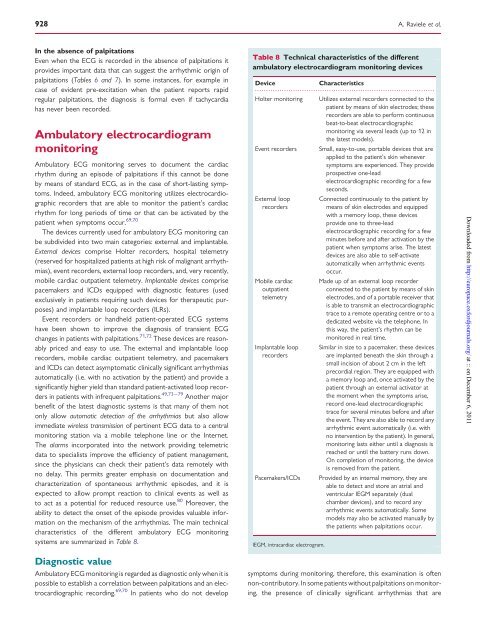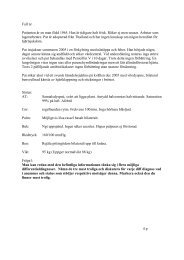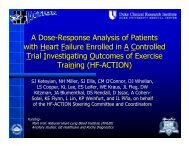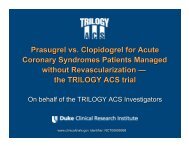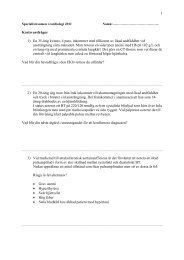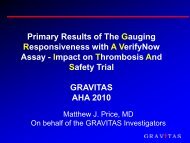Management of patients with palpitations: a position paper from the ...
Management of patients with palpitations: a position paper from the ...
Management of patients with palpitations: a position paper from the ...
You also want an ePaper? Increase the reach of your titles
YUMPU automatically turns print PDFs into web optimized ePapers that Google loves.
928A. Raviele et al.In <strong>the</strong> absence <strong>of</strong> <strong>palpitations</strong>Even when <strong>the</strong> ECG is recorded in <strong>the</strong> absence <strong>of</strong> <strong>palpitations</strong> itprovides important data that can suggest <strong>the</strong> arrhythmic origin <strong>of</strong><strong>palpitations</strong> (Tables 6 and 7). In some instances, for example incase <strong>of</strong> evident pre-excitation when <strong>the</strong> patient reports rapidregular <strong>palpitations</strong>, <strong>the</strong> diagnosis is formal even if tachycardiahas never been recorded.Ambulatory electrocardiogrammonitoringAmbulatory ECG monitoring serves to document <strong>the</strong> cardiacrhythm during an episode <strong>of</strong> <strong>palpitations</strong> if this cannot be doneby means <strong>of</strong> standard ECG, as in <strong>the</strong> case <strong>of</strong> short-lasting symptoms.Indeed, ambulatory ECG monitoring utilizes electrocardiographicrecorders that are able to monitor <strong>the</strong> patient’s cardiacrhythm for long periods <strong>of</strong> time or that can be activated by <strong>the</strong>patient when symptoms occur. 69,70The devices currently used for ambulatory ECG monitoring canbe subdivided into two main categories: external and implantable.External devices comprise Holter recorders, hospital telemetry(reserved for hospitalized <strong>patients</strong> at high risk <strong>of</strong> malignant arrhythmias),event recorders, external loop recorders, and, very recently,mobile cardiac outpatient telemetry. Implantable devices comprisepacemakers and ICDs equipped <strong>with</strong> diagnostic features (usedexclusively in <strong>patients</strong> requiring such devices for <strong>the</strong>rapeutic purposes)and implantable loop recorders (ILRs).Event recorders or handheld patient-operated ECG systemshave been shown to improve <strong>the</strong> diagnosis <strong>of</strong> transient ECGchanges in <strong>patients</strong> <strong>with</strong> <strong>palpitations</strong>. 71,72 These devices are reasonablypriced and easy to use. The external and implantable looprecorders, mobile cardiac outpatient telemetry, and pacemakersand ICDs can detect asymptomatic clinically significant arrhythmiasautomatically (i.e. <strong>with</strong> no activation by <strong>the</strong> patient) and provide asignificantly higher yield than standard patient-activated loop recordersin <strong>patients</strong> <strong>with</strong> infrequent <strong>palpitations</strong>. 49,73 – 79 Ano<strong>the</strong>r majorbenefit <strong>of</strong> <strong>the</strong> latest diagnostic systems is that many <strong>of</strong> <strong>the</strong>m notonly allow automatic detection <strong>of</strong> <strong>the</strong> arrhythmias but also allowimmediate wireless transmission <strong>of</strong> pertinent ECG data to a centralmonitoring station via a mobile telephone line or <strong>the</strong> Internet.The alarms incorporated into <strong>the</strong> network providing telemetricdata to specialists improve <strong>the</strong> efficiency <strong>of</strong> patient management,since <strong>the</strong> physicians can check <strong>the</strong>ir patient’s data remotely <strong>with</strong>no delay. This permits greater emphasis on documentation andcharacterization <strong>of</strong> spontaneous arrhythmic episodes, and it isexpected to allow prompt reaction to clinical events as well asto act as a potential for reduced resource use. 80 Moreover, <strong>the</strong>ability to detect <strong>the</strong> onset <strong>of</strong> <strong>the</strong> episode provides valuable informationon <strong>the</strong> mechanism <strong>of</strong> <strong>the</strong> arrhythmias. The main technicalcharacteristics <strong>of</strong> <strong>the</strong> different ambulatory ECG monitoringsystems are summarized in Table 8.Diagnostic valueAmbulatory ECG monitoring is regarded as diagnostic only when it ispossible to establish a correlation between <strong>palpitations</strong> and an electrocardiographicrecording. 69,70 In <strong>patients</strong> who do not developTable 8 Technical characteristics <strong>of</strong> <strong>the</strong> differentambulatory electrocardiogram monitoring devicesDeviceCharacteristics................................................................................Holter monitoring Utilizes external recorders connected to <strong>the</strong>patient by means <strong>of</strong> skin electrodes; <strong>the</strong>serecorders are able to perform continuousbeat-to-beat electrocardiographicmonitoring via several leads (up to 12 in<strong>the</strong> latest models).Event recorders Small, easy-to-use, portable devices that areapplied to <strong>the</strong> patient’s skin wheneversymptoms are experienced. They provideprospective one-leadelectrocardiographic recording for a fewseconds.External looprecordersMobile cardiacoutpatienttelemetryImplantable looprecordersPacemakers/ICDsIEGM, intracardiac electrogram.Connected continuously to <strong>the</strong> patient bymeans <strong>of</strong> skin electrodes and equipped<strong>with</strong> a memory loop, <strong>the</strong>se devicesprovide one to three-leadelectrocardiographic recording for a fewminutes before and after activation by <strong>the</strong>patient when symptoms arise. The latestdevices are also able to self-activateautomatically when arrhythmic eventsoccur.Made up <strong>of</strong> an external loop recorderconnected to <strong>the</strong> patient by means <strong>of</strong> skinelectrodes, and <strong>of</strong> a portable receiver thatis able to transmit an electrocardiographictrace to a remote operating centre or to adedicated website via <strong>the</strong> telephone. Inthis way, <strong>the</strong> patient’s rhythm can bemonitored in real time.Similar in size to a pacemaker, <strong>the</strong>se devicesare implanted beneath <strong>the</strong> skin through asmall incision <strong>of</strong> about 2 cm in <strong>the</strong> leftprecordial region. They are equipped <strong>with</strong>a memory loop and, once activated by <strong>the</strong>patient through an external activator at<strong>the</strong> moment when <strong>the</strong> symptoms arise,record one-lead electrocardiographictrace for several minutes before and after<strong>the</strong> event. They are also able to record anyarrhythmic event automatically (i.e. <strong>with</strong>no intervention by <strong>the</strong> patient). In general,monitoring lasts ei<strong>the</strong>r until a diagnosis isreached or until <strong>the</strong> battery runs down.On completion <strong>of</strong> monitoring, <strong>the</strong> deviceis removed <strong>from</strong> <strong>the</strong> patient.Provided by an internal memory, <strong>the</strong>y areable to detect and store an atrial andventricular IEGM separately (dualchamber devices), and to record anyarrhythmic events automatically. Somemodels may also be activated manually by<strong>the</strong> <strong>patients</strong> when <strong>palpitations</strong> occur.symptoms during monitoring, <strong>the</strong>refore, this examination is <strong>of</strong>tennon-contributory. In some <strong>patients</strong> <strong>with</strong>out <strong>palpitations</strong> on monitoring,<strong>the</strong> presence <strong>of</strong> clinically significant arrhythmias that areDownloaded <strong>from</strong> http://europace.oxfordjournals.org/ at :: on December 6, 2011


